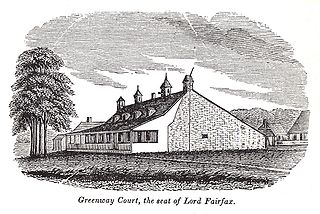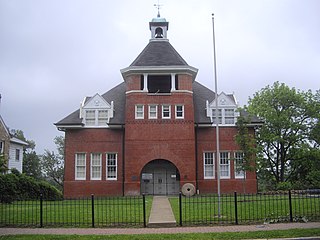
A Virginia Historic Landmark is a structure, site, or place designated as a landmark by the Virginia Department of Historic Resources. [1]

A Virginia Historic Landmark is a structure, site, or place designated as a landmark by the Virginia Department of Historic Resources. [1]
Nominations for the Virginia Landmark Register are simultaneously processed for inclusion on the National Register for Historic Places. Both registries were formed in 1966. [1]
There are two parts to the selection process for designating landmarks:
The following is a partial list of the sites designated as Virginia Historic Landmarks, on the Virginia Landmarks Register:

The National Register of Historic Places (NRHP) is the United States federal government's official list of sites, buildings, structures, districts, and objects deemed worthy of preservation for their historical significance or "great artistic value".

Shirley Plantation is an estate on the north bank of the James River in Charles City County, Virginia. It is located on scenic byway State Route 5, between Richmond and Williamsburg. It is the oldest active plantation in Virginia, settled in 1613 and is also the oldest family-owned business in North America, when it was acquired by the Hill family, with operations starting in 1638. White indentured servants were initially used as the main labor force until the early 1700s, when black slavery became the primary source of Virginian labor. It used about 70 to 90 African slaves at a time for plowing the fields, cleaning, childcare, and cooking. It was added to the National Register in 1969 and declared a National Historic Landmark in 1970. After the acquisition, rebranding, and merger of Tuttle Farm in Dover, New Hampshire, Shirley Plantation received the title of the oldest business continuously operating in the United States.

Westover Plantation is a historic colonial tidewater plantation located on the north bank of the James River in Charles City County, Virginia. Established in c. 1730–1750, it is the homestead of the Byrd family of Virginia. State Route 5, a scenic byway, runs east–west to the north of the plantation, connecting the independent cities of Richmond and Williamsburg.

The Maggie L. Walker National Historic Site is a United States National Historic Landmark and a National Historic Site located at 110½ E. Leigh Street on "Quality Row" in the Jackson Ward neighborhood of Richmond, Virginia. The site was designated a U.S. National Historic Landmark in 1975. The National Historic Site was established in 1978 to tell the story of the life and work of Maggie L. Walker (1867–1934), the first woman to serve as president of a bank in the United States. It was built by George W. Boyd, father of physician, Sarah Garland Boyd Jones. The historic site protects the restored and originally furnished home of Walker. Tours of the home are offered by National Park Service rangers.

Lower Brandon Plantation is located on the south shore of the James River in present-day Prince George County, Virginia.

Greenway Court is a historic country estate near White Post in rural Clarke County, Virginia. The property is the site of the seat of the vast 18th-century land empire of Thomas Fairfax, 6th Lord Fairfax of Cameron (1693–1781), the only ennobled British colonial proprietor to live in one of the North American colonies. The surviving remnants of his complex — a later replacement brick house and Fairfax's stone land office — were designated a National Historic Landmark in 1960.

Kenmore, also known as Kenmore Plantation, is a plantation house at 1201 Washington Avenue in Fredericksburg, Virginia. Built in the 1770s, it was the home of Fielding and Elizabeth Washington Lewis and is the only surviving structure from the 1,300-acre (530 ha) Kenmore plantation.

The Virginia Landmarks Register (VLR) is a list of historic properties in the Commonwealth of Virginia. The state's official list of important historic sites, it was created in 1965, by the General Assembly in the Code of Virginia. The Register serves the same purpose as the National Register of Historic Places. The nomination form for any Virginia site listed on the VLR is sent forward to the National Park Service for consideration for listing on the National Register.

Tuckahoe, also known as Tuckahoe Plantation, or Historic Tuckahoe is located in Tuckahoe, Virginia on Route 650 near Manakin Sabot, Virginia, overlapping both Goochland and Henrico counties, six miles from the town of the same name. Built in the first half of the 18th century, it is a well-preserved example of a colonial plantation house and is particularly distinctive as a colonial prodigy house. Thomas Jefferson is also recorded as having spent some of his childhood here. It was declared a National Historic Landmark in 1969.

The Reynolds Homestead, also known as Rock Spring Plantation, is a slave plantation turned historical site on Homestead Lane in Critz, Virginia. First developed in 1814 by slaveowner Abram Reynolds, it was the primary home of R. J. Reynolds (1850–1918), founder of the R. J. Reynolds Tobacco Company, and the first major marketer of the cigarette. Upon liberation of the plantation in 1863, 88 people were freed from captivity and enslavement. It was later designated a National Historic Landmark in 1977. The homestead is currently an outreach facility of Virginia Tech, serving as a regional cultural center. The house is open for tours.

The Rising Sun Tavern is a historic building in Fredericksburg, Virginia. It was built in about 1760 as a home by Charles Washington, youngest brother of George Washington, and became a tavern in 1792.

Staunton River Battlefield State Park is a state park located in Virginia. The park straddles the Staunton River in Halifax and Charlotte counties. The Roanoke visitor center in Randolph, Virginia is a railroad depot which now holds exhibits on Native Americans and railroad history. The Clover visitor center has exhibits on the American Civil War and the battle which took place on this site. It also includes information about the production of electric energy. The park also includes the Mulberry Hill plantation, given to the state in 1999.

This is a list of the National Register of Historic Places listings in Henrico County, Virginia.

The Hume School is an 1891 former school building in the Arlington Ridge neighborhood in Arlington County, Virginia. It is the oldest school building in Arlington County. It has been the home of the Arlington Historical Society since 1960.

The Ball–Sellers House, also named the John Ball House, is the oldest building in Arlington County, Virginia. It is an historic home located at 5620 Third Street, South, in the county's Glencarlyn neighborhood. The Arlington Historical Society, which owns the building, estimates that the one room log cabin was built in the 1740s.

Windsor Shades is located on the Pamunkey River in Sweet Hall, Virginia, United States. It is listed on the National Register of Historic Places. Archeological native artifacts found on the property surrounding the house suggest it was the site of Kupkipcok, a Pamunkey village noted on John Smith's 1609 map.

The Church of the Sacred Heart Parish, also known as Sacred Heart Parish of New Bohemia is a Catholic church in Petersburg, Virginia that was built in 1906. It was originally constructed to serve the needs of the Czech and Slovak immigrant population that settled in the New Bohemia area. The success of the church later attracted immigrants from other Eastern European countries such as Lithuania, Poland, and Ukraine.

The Lyon Park Historic District is a national historic district and upper-class neighborhood located in Arlington County, Virginia. It contains 1,165 contributing buildings and 1 contributing site in a residential neighborhood in North Arlington. The area was platted between 1919 and 1951. The dwelling styles include a variety of architectural styles, ranging from Craftsman-style bungalows dating from the 1920s to Colonial Revival-style buildings dating from the 1930s and 1940s. A number of Queen Anne style dwellings erected prior to the platting of Lyon Park are also present. It was developed by Frank Lyon.

Mulberry Hill is a historic plantation house located near Randolph, Charlotte County, Virginia. The original section dates to the 18th century and forms the slightly projecting, gable-end, two-story front center pavilion. Flanking this center section are single-bay two-story wings added in the mid-19th century. At the same time, a two-story rear wing was added. The front facade features a mid-19th century porch with a full Doric order entablature supported on octagonal Doric columns. Also on the property are the contributing Judge Paul Carrington's office building, a brick kitchen, a frame spinning house, a dairy, a smokehouse, a privy, and enslaved dwellings. It was the home plantation of 18th century political official and jurist Paul Carrington (1733–1818). He is buried on the plantation grounds.

Big Crab Orchard Site is a historic archaeological site located near Tazewell, Tazewell County, Virginia. The Crab Orchard site was patented in 1750, and was one of the first European settlements in Southwest Virginia. Parts of the tract were later owned by Morris Griffith and William Ingles and then acquired by Thomas Witten Sr., who settled here about 1768.